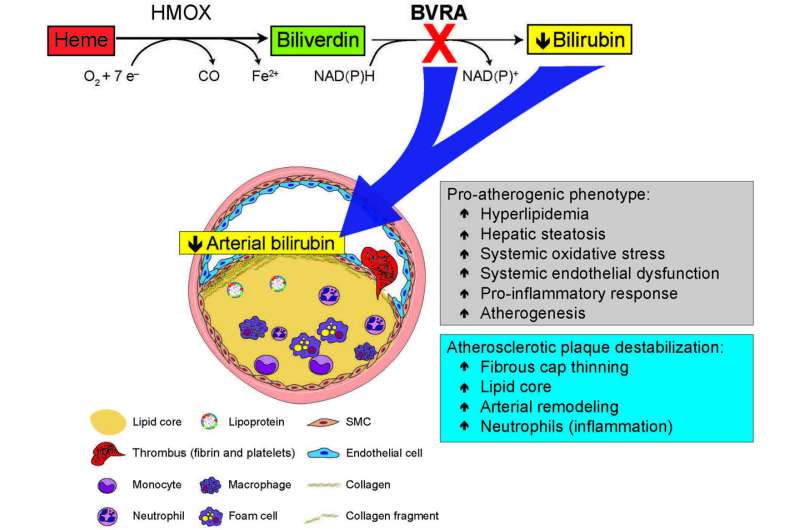This article has been reviewed according to Science X's editorial process and policies. Editors have highlighted the following attributes while ensuring the content's credibility:
fact-checked
peer-reviewed publication
proofread
Destabilization of atherosclerotic plaque by bilirubin deficiency

Atherosclerosis is the main underlying cause of cardiovascular disease (CVD). In this process, plaque made of fat, cholesterol, calcium, and other substances builds up on the artery walls.
Plaque that remains on the artery wall is considered 'stable', although it can harden and narrow the arteries over time. Plaque can become 'unstable' and break open, potentially forming a blood clot that could cause a life-threatening heart attack or stroke if it lodges in an artery to the heart or brain. This dangerous plaque is the focus of Dr. Weiyu Chen's recent publication "Destabilization of atherosclerotic plaque by bilirubin deficiency".
Bilirubin is a yellowish pigment produced during the breakdown of red blood cells and modified in the liver to allow its excretion from the body. Increased bilirubin levels are responsible for the yellow discoloration seen in jaundice.
A study published in the journal Circulation Research expands on pioneering work by Prof Roland Stocker, Emeritus Fellow at HRI, which discovered that people with slightly elevated levels of bilirubin in their blood were protected from developing CVD, contrary to the prior view of bilirubin as only a toxic waste product.
"For example, Gilbert's syndrome, a mild liver disorder affecting four to 16 percent of people and characterized by slightly increased bilirubin levels, is associated with a three-fold decrease in CVD risk," says Dr. Chen.
The research by Dr. Chen and a team of researchers from HRI and The University of Sydney led by Prof Stocker discovered that bilirubin deficiency further destabilizes unstable atherosclerotic plaque, therefore increasing the risk of heart attack or stroke. This takes the team into an exciting new phase, as these findings support the notion that increases in circulating bilirubin may be worth considering as a strategy to lower the risk of CVD.
The next step will be to use genetic or pharmacological strategies, for example to inhibit the activity of bilirubin UDP-glucuronosyltransferase, which is the enzyme responsible for eliminating bilirubin from the body, to stabilize atherosclerotic plaque.
"Understanding how bilirubin decreases the risk of CVD will give rise to novel strategies for developing a new generation of therapeutics to treat and prevent CVD," says Dr. Chen.
More information: Weiyu Chen et al, Destabilization of Atherosclerotic Plaque by Bilirubin Deficiency, Circulation Research (2023). DOI: 10.1161/CIRCRESAHA.122.322418





















